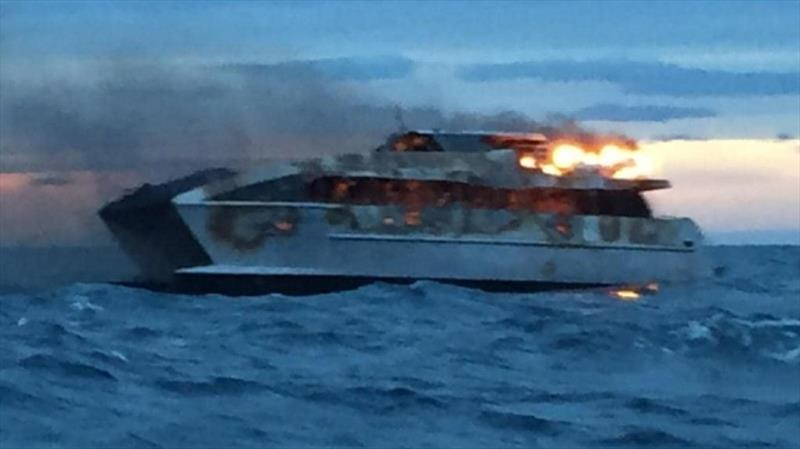
AMSA Safety Alert - Fire prevention and protection
by Australian Maritime Safety Authority 8 Aug 2020 14:49 NZST

Spirit of 1770 burning off Bundaberg Qld © Australian Maritime Safety Authority
This safety alert from the Australian Maritime Safety Authority aims to raise awareness of measures to ensure the fire risks on your vessel are appropriately managed.
Addressing the risk of fire
Make sure your safety management system (SMS) includes:
- planned maintenance of your vessel's firefighting, fire-containment and fire-prevention equipment
- emergency procedures in the event of a fire
- training and induction for crew members on emergency procedures and how to use firefighting equipment and
- first aid for injuries caused by fire or smoke.
Common issues that reduce fire protection
Poor maintenance of vessels and its fire protection equipment are major contributors to vessel fires.
A recent AMSA inspection campaign focusing on fire prevention on passenger vessels revealed 829 instances of poor fire-system maintenance across 326 vessels. The most common issues identified were:
- emergency fire pump could not supply adequate water pressure to fight a fire
- portable extinguishers were not maintained in accordance with Australian Standard (AS) 1851-2012
- lack of, or poorly maintained fire insulation, protection or suppression systems
- emergency shutoffs in engine room not working
- fire alarm strobe light in engine room not working
- assessment of fire risk not updated as part of the SMS
- fire detectors not working
- poor or inadequate signage for fire flaps or emergency shut-off valves.
An analyses of AMSA's marine incident reports and inspection data shows similar issues across all vessel types.
Fire protection
It is important to ensure that vessels have both passive (for example structural) and active fire protection measures to minimise the spread of fire if it occurs.
Active fire protection
Most people are familiar with active fire protection measures, such as fire detection systems and alarms, fixed and portable fire-extinguishing systems, and fire blankets. It is important that these devices are in place and operate effectively.
Passive fire protection
Passive structural fire protection is also an important control measure because it slows the spread of fire and protects essential systems, giving crew more time to fight a fire or—in a worst case scenario—abandon the vessel before lives are lost.
Passive structural fire protection is essentially the installation of fire-resistant material on the vessel structure, such as fire-resistant bulkheads, deck heads, decks and doors.
Structural fire protection measures help to break the fire triangle by removing the transfer of heat to other compartments in a vessel, especially high-risk zones like the engine room, and accommodation areas.
The type of material and thickness used for passive structural fire protection will depend on what materials need protection. For example, steel begins to lose its design margin of safety at temperatures of around 550oC, whereas for aluminium the temperature is much lower, at around 150oC. Further, at 275oC aluminium will lose around 50% of its yield strength.
Your accredited marine surveyor can advise on what materials may be suitable for your application and the specifications you need to meet on your vessel.
Maintaining your passive structural fire protection
It's common to see a fire-rated division—such as the bulkhead in an engine room—penetrated during a modification, docking or a periodic survey. Electricians, plumbers, or communication engineers can leave unintended holes in the fire-rated division as they perform maintenance and upgrades.
These openings reduce the effectiveness of the structural fire protection. If there is a fire, heat will be able to escape where the structural fire protection has been penetrated or compromised, allowing the fire to spread to the adjoining compartment.
Passive structural fire protection is a critical element of a vessel's fire protection system, preserving vessels, lives and livelihoods from the threat of fire. Vessel owners, skippers and surveyors need to pay special attention to fire-rated divisions to ensure the original approved specification is maintained.
Reminder
- Ensure fire prevention measures are in place and part of your risk assessment to reduce the risk of fire
- Review your risk-assessment for your operation regularly
- Ensure fire prevention, fire containment, and firefighting equipment are included in your planned maintenance
- Ensure the integrity of passive structural fire protection is maintained.